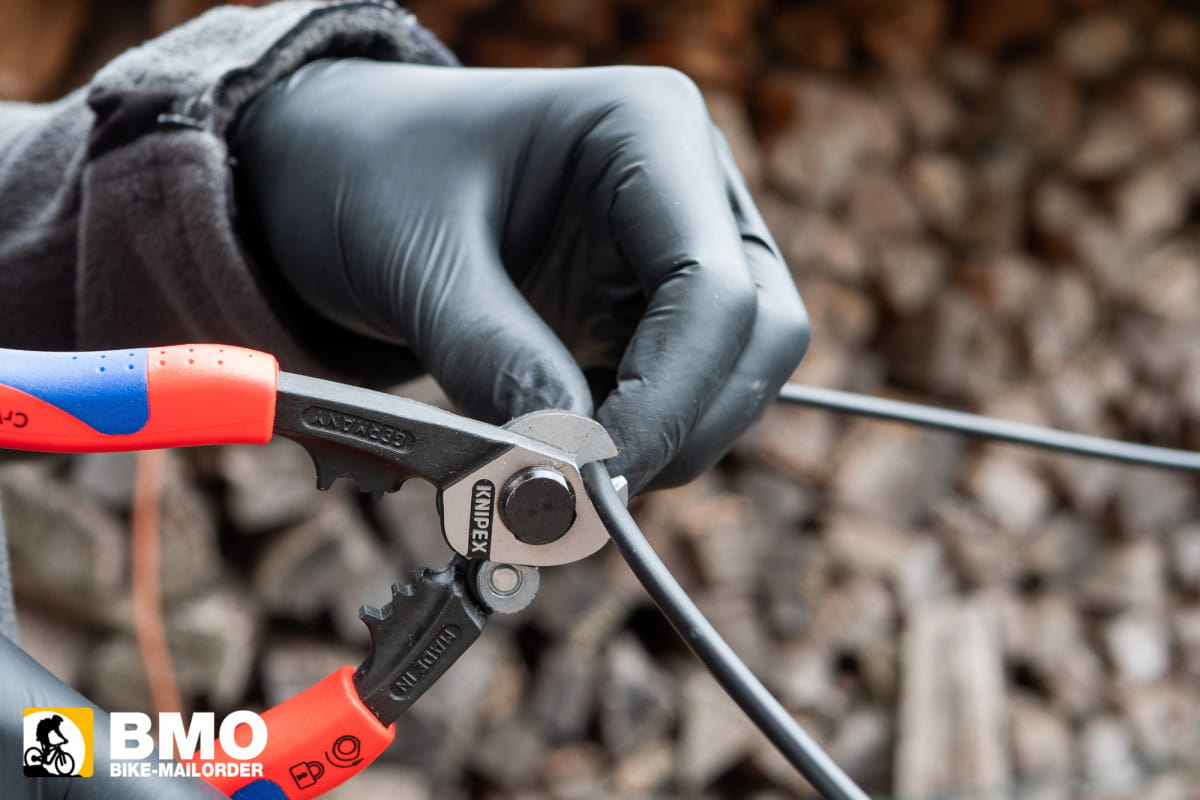You bought a new hydraulic disc brake for your bike and when installing it, you notice that the brake lines are too long. Especially Magura supplies brakes with a decent cable length, but also SRAM and Shimano equip their brakes in most cases with lines that are too long for practically any bike.
This is a good thing – because as you will learn in our guide, shortening the line is not a problem at all. Extending it would be much more complicated, as it would require a complete replacement of the brake lines.
In this tutorial, we will show you how to shorten the brake line with just a few steps and perfectly adjust it to your bike. We demonstrate the necessary steps on a SRAM G2, but the shortening of the lines is similar for all manufacturers and all models.
What do you need to shorten a brake line?
Of course, you can't shorten a brake line without tools. Besides the new brake (and your bike, of course), you need some tools.

The most important tools for shortening a brake line on a bike.
To shorten a brake line on a bike, you need the following tools:
- Hammer (not for SRAM brakes)
- Pipe wrench
- Cable cutter
- Tool for removing the brake pads
- Torque wrench with various bits (suitable for your bike)
- Torx or Allen key for the handlebar clamp
- Protective gloves
- 8mm open-end wrench
- Spacer for the brake pistons
- Clamping jaws for the brake cables
↪ You can find tools and bike tools in the BMO online shop
The following accessories are included in the delivery of most bike brakes:
• Olive (clamping ring) for the hydraulic line
• Insert pin for the hydraulic line
• Torx angle wrench T10/T25 (only necessary for SRAM)
Shortening bike brake lines – step by step
The first step is to prepare the bike for the upcoming tinkering session.
Preparation comes before shortening
-
To have free hands, it's best to clamp your bike in a repair stand. Then remove the front wheel to protect the brake disc from dirt and oil.

-
Also the brake pads you should ensure this, because when shortening the brake line, some brake fluid may leak out, which would ruin it.

-
The brake pistons inside the caliper are carefully pushed back and fixed with a spacer.

-
To avoid losing too much brake fluid later on, the brake lever is loosened and aligned upwards. Due to the vertical alignment, the line connection is inclined upwards and the brake fluid cannot flow out unhindered.

Loosening the Brake Line
-
Step five gets exciting. Pull the protective cap of the brake lever back to expose the union nut.

-
Next, loosen the union nut with an 8 mm open-end wrench to remove the end of the brake line from the brake master cylinder. When pulling out the line, you should proceed very carefully, as brake fluid may leak out. Skin contact should be avoided at all costs, which is why wearing protective gloves is recommended. The union nut and protective cap remain on the line so you don't lose them.


Determine the Length of the Brake Line
Now comes an important step: You can determine the appropriate length of the brake line.
-
To do this, steer fully and hold the cable up to the connection of the brake lever. The line should pass closely by the frame but not touch it, so it does not damage the paint. The vertical position of the brake lever provides some additional millimeters of buffer in the length, so you can ensure that the line is not too short.


Now the brake line is being shortened!
-
Mark the required length, that is, the point where you will cut the line. Then you can shorten it with a cable cutter. It may be tempting to just use side cutters here, but the straight blades can crush the brake line, and in the worst case, it may no longer fit into the fitting.

Assembly of the shortened brake line
-
After the actual shortening, we clamp the line using a pipe wrench and the clamping jaws. You should never work without the clamping aid here, as otherwise the line can be crushed or even damaged. You should also check again that both the protective cap, which we loosened in step five, and the lock nut are in the correct order on the line (first the protective cap, then the lock nut).

|
Note: For other manufacturers (i.e., not SRAM), the olive must also be threaded onto the brake line after the lock nut. Pay attention to the correct order: protective cap, lock nut, olive. Important: The order cannot be changed after the insert pin is mounted. For a SRAM brake, the olive is screwed on only after inserting the insert pin. |
-
The next step involves the assembly of the shortened brake line. To be able to attach it back to the master cylinder, a new insert pin and an olive must be installed. Both parts are included in the package of a new brake from almost all manufacturers.
- Since we are performing the assembly of a SRAM G2 brake, the pin is screwed in. The appropriate Torx key is also included.
- For other manufacturers like Magura or Shimano, the insert pin is gently tapped in with a hammer.
- In both options, we first push the pin by hand a bit into the line, in order to then drive it into the sleeve up to the head with the appropriate tool.


For SRAM brakes, the olive, also called a clamping ring, is now screwed onto the insert pin. For other manufacturers, the clamping ring has already been pushed onto the line.

-
Now the brake line is fed back into the brake lever and mounted. When tightening the union nut, the cable must be pressed firmly into the opening the entire time. Only then is a flawless assembly possible.


-
Tighten the nut to about 8 Nm and check if the line holds. A slight pull on the brake line will show you if the brake line is securely seated in the lever.
-
Afterwards, you push the protective cap back into its position and the main work is done.

-
Now only the reassembly of the bike is missing. Align the brake lever properly again and mount the brake pads and the wheel, which were removed at the beginning for protection

Test the brake adjustment
In the last step, you check the pressure point of the brake.
15. If this is not optimal after multiple actuations, you may need to bleed the brake. Another reason for insufficient function can be the loss of brake fluid. Actually, setting up the lever in step four should prevent this, but fluid can still be lost.

The brake line is shortened and mounted...
... and when everything is perfectly set and controlled, the trail fun can go to the next round. This assembly is absolutely doable for experienced tinkerers, but if you are (still) not familiar or have an uncertain feeling about it, you should ask a professional or at least have your work checked by someone. The brake of your bike is really essential for your safety, if something is wrong here and the brake does not work properly on the trail, it can lead to painful accidents.




